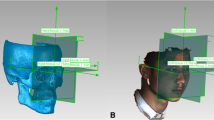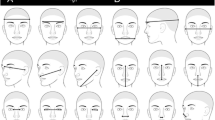Abstract
Objectives
Dolichofacial (long-faced) and brachyfacial (short-faced) individuals show specific and well-differentiated craniofacial morphology. Here, we hypothesise that differences in the basicranial orientation and topology between dolicho- and brachyfacial subjects could be associated with differences in the supporting brain tissues.
Material and methods
Brain volumes (total intracranial, grey matter, and white matter volume), cortical thickness, and the volumes and shapes of fifteen subcortical nuclei were assessed on the basis of magnetic resonance imaging in 185 subjects. Global, voxel-wise and shape analyses, as well as multiple regression models, were generated to evaluate the association between vertical facial variations (dolicho- and brachyfacial spectrum) and brain morphology.
Results
Several differences in brain anatomy between dolicho- and brachyfacial subjects, along with relevant associations between vertical facial indices and brain structure and shape, were found. The most relevant finding of this study is related to the strong association of vertical facial indices with the volumes and shapes of subcortical nuclei, as the dolichofacial pattern increased, the bilateral hippocampus and brain stem expanded, while the left caudate, right pallidus, right amygdala, and right accumbens decreased in volume.
Conclusions
Long- and short-faced human subjects present differences in brain structure and shape.
Clinical significant
The results of our study increase the clinician’s knowledge about brain structure in dolicho- and brachyfacial patients. The findings could be of interest since the affected brain areas are involved in higher cognitive functions in humans, including language, memory, and attention.





Similar content being viewed by others
References
Enlow DH (1990) Facial growth. 3rd edn. W. B. Saunders Company, Philadelphia
Lieberman DE (1998) Sphenoid shortening and the evolution of modern human cranial shape. Nature 393:158–162
Bastir M, Rosas A (2016) Cranial base topology and basic trends in the facial evolution of Homo. J Hum Evol 91:26–35. https://doi.org/10.1016/j.jhevol.2015.11.001
Lieberman D (2011) The evolution of the human head. Harvard University Press, Cambridge
Jeffery N, Spoor F (2002) Brain size and the human cranial base: a prenatal perspective. Am J Phys Anthropol 118:324–340. https://doi.org/10.1002/ajpa.10040
Bastir M, Rosas A, Stringer C, Manuel Cuétara J, Kruszynski R, Weber GW, Ross CF, Ravosa MJ (2010) Effects of brain and facial size on basicranial form in human and primate evolution. J Hum Evol 58(5):424–431. https://doi.org/10.1016/j.jhevol.2010.03.001
Zollikofer CP, Ponce De Leon MS (2002) Visualizing patterns of craniofacial shape variation in Homo sapiens. Proc Biol Sci 269(1493):801–807. https://doi.org/10.1098/rspb.2002.1960
Bastir M, Rosas A (2004) Facial heights: evolutionary relevance of postnatal ontogeny for facial orientation and skull morphology in humans and chimpanzees. J Hum Evol 47(5):359–381. https://doi.org/10.1016/j.jhevol.2004.08.009
Alarcon JA, Bastir M, Garcia-Espona I, Menendez-Nunez M, Rosas A (2014) Morphological integration of mandible and cranium: orthodontic implications. Arch Oral Biol 59(1):22–29. https://doi.org/10.1016/j.archoralbio.2013.10.005
Enlow DH, Hans MG (1996) Essentials of facial growth. W. B. Saunders Company,
Bastir M, Rosas A, Gunz P, Pena-Melian A, Manzi G, Harvati K, Kruszynski R, Stringer C, Hublin J-J (2011) Evolution of the base of the brain in highly encephalized human species. Nat Commun 2:588. https://doi.org/10.1038/ncomms1593
Buckner RL, Krienen FM (2013) The evolution of distributed association networks in the human brain. Trends Cogn Sci 17(12):648–665. https://doi.org/10.1016/j.tics.2013.09.017
Juerchott A, Freudlsperger C, Zingler S, Saleem MA, Jende JME, Lux CJ, Bendszus M, Heiland S, Hilgenfeld T (2019) In vivo reliability of 3D cephalometric landmark determination on magnetic resonance imaging: a feasibility study. Clin Oral Investig. https://doi.org/10.1007/s00784-019-03015-7
Steiner CC (1953) Cephalometrics for you and me. Am J Orthod 39(10):729–755
Proffit WR, Fields HM, Sarver DM (2007) Contemporary orthodontics, 4th edn. CV Mosby, St. Luis
Riolo ML, Moyers RE, McNamara JA (1974) An atlas of craniofacial growth : cephalometric standards from university school growth study, the University of Michigan. University of Michigan, Estados Unidos
Siriwat PP, Jarabak JR (1985) Malocclusion and facial morphology is there a relationship? An epidemiologic study. Angle Orthod 55(2):127–138. https://doi.org/10.1043/0003-3219(1985)055<0127:mafmit>2.0.co;2
Dahnke R, Yotter RA, Gaser C (2013) Cortical thickness and central surface estimation. NeuroImage 65:336–348. https://doi.org/10.1016/j.neuroimage.2012.09.050
Patenaude B, Smith SM, Kennedy DN, Jenkinson M (2011) A Bayesian model of shape and appearance for subcortical brain segmentation. NeuroImage 56(3):907–922. https://doi.org/10.1016/j.neuroimage.2011.02.046
Tzourio-Mazoyer N, Landeau B, Papathanassiou D, Crivello F, Étard O, Delcroix N, Mazoyer B, Joliot M (2002) Automated anatomical labeling of activations in SPM using a macroscopic anatomical parcellation of the MNI MRI single-subject brain. NeuroImage 15:273–289. https://doi.org/10.1006/nimg.2001.0978
Macpherson T, Hikida T (2019) Role of basal ganglia neurocircuitry in the pathology of psychiatric disorders. Psychiatry Clin Neurosci 73(6):289–301. https://doi.org/10.1111/pcn.12830
Bickart KC, Wright CI, Dautoff RJ, Dickerson BC, Barrett LF (2011) Amygdala volume and social network size in humans. Nat Neurosci 14(2):163–164. https://doi.org/10.1038/nn.2724
Barger N, Stefanacci L, Semendeferi K (2007) A comparative volumetric analysis of the amygdaloid complex and basolateral division in the human and ape brain. Am J Phys Anthropol 134(3):392–403. https://doi.org/10.1002/ajpa.20684
Avino TA, Barger N, Vargas MV, Carlson EL, Amaral DG, Bauman MD, Schumann CM (2018) Neuron numbers increase in the human amygdala from birth to adulthood, but not in autism. Proc Natl Acad Sci U S A 115(14):3710–3715. https://doi.org/10.1073/pnas.1801912115
Shultz S, Dunbar RIM (2010) Species differences in executive function correlate with hippocampus volume and neocortex ratio across nonhuman primates. J Comp Psychol 124(3):252–260. https://doi.org/10.1037/a0018894
Pauli WM, O'Reilly RC, Yarkoni T, Wager TD (2016) Regional specialization within the human striatum for diverse psychological functions. Proc Natl Acad Sci U S A 113(7):1907–1912. https://doi.org/10.1073/pnas.1507610113
Rikhye RV, Wimmer RD, Halassa MM (2018) Toward an integrative theory of thalamic function. Annu Rev Neurosci 41:163–183. https://doi.org/10.1146/annurev-neuro-080317-062144
Wolff M, Vann SD (2019) The cognitive thalamus as a gateway to mental representations. J Neurosci 39(1):3–14. https://doi.org/10.1523/JNEUROSCI.0479-18.2018
Rikhye RV, Gilra A, Halassa MM (2018) Thalamic regulation of switching between cortical representations enables cognitive flexibility. Nat Neurosci 21(12):1753–1763. https://doi.org/10.1038/s41593-018-0269-z
Abutalebi J, Annoni JM, Zimine I, Pegna AJ, Seghier ML, Lee-Jahnke H, Lazeyras F, Cappa SF, Khateb A (2008) Language control and lexical competition in bilinguals: an event-related FMRI study. Cereb Cortex 18(7):1496–1505. https://doi.org/10.1093/cercor/bhm182
Burgaleta M, MacDonald PA, Martinez K, Roman FJ, Alvarez-Linera J, Ramos Gonzalez A, Karama S, Colom R (2014) Subcortical regional morphology correlates with fluid and spatial intelligence. Hum Brain Mapp 35(5):1957–1968. https://doi.org/10.1002/hbm.22305
Burgaleta M, Sanjuan A, Ventura-Campos N, Sebastian-Galles N, Avila C (2016) Bilingualism at the core of the brain. Structural differences between bilinguals and monolinguals revealed by subcortical shape analysis. NeuroImage 125:437–445. https://doi.org/10.1016/j.neuroimage.2015.09.073
Erickson KI, Boot WR, Basak C, Neider MB, Prakash RS, Voss MW, Graybiel AM, Simons DJ, Fabiani M, Gratton G, Kramer AF (2010) Striatal volume predicts level of video game skill acquisition. Cereb Cortex 20(11):2522–2530. https://doi.org/10.1093/cercor/bhp293
Woodward ND, Zald DH, Ding Z, Riccardi P, Ansari MS, Baldwin RM, Cowan RL, Li R, Kessler RM (2009) Cerebral morphology and dopamine D2/D3 receptor distribution in humans: a combined [18F]fallypride and voxel-based morphometry study. NeuroImage 46(1):31–38. https://doi.org/10.1016/j.neuroimage.2009.01.049
Neubauer S, Hublin JJ, Gunz P (2018) The evolution of modern human brain shape. Sci Adv 4(1):eaao5961. https://doi.org/10.1126/sciadv.aao5961
Ansell EB, Rando K, Tuit K, Guarnaccia J, Sinha R (2012) Cumulative adversity and smaller gray matter volume in medial prefrontal, anterior cingulate, and insula regions. Biol Psychiatry 72(1):57–64. https://doi.org/10.1016/j.biopsych.2011.11.022
Winkler AM, Kochunov P, Blangero J, Almasy L, Zilles K, Fox PT, Duggirala R, Glahn DC (2010) Cortical thickness or grey matter volume? The importance of selecting the phenotype for imaging genetics studies. Neuroimage 53(3):1135–1146. https://doi.org/10.1016/j.neuroimage.2009.12.028
Ono Y, Yamamoto T, Kubo KY, Onozuka M (2010) Occlusion and brain function: mastication as a prevention of cognitive dysfunction. J Oral Rehabil 37(8):624–640. https://doi.org/10.1111/j.1365-2842.2010.02079.x
Lotze M, Domin M, Kordass B (2017) Symmetry of fMRI activation in the primary sensorimotor cortex during unilateral chewing. Clin Oral Investig 21(4):967–973. https://doi.org/10.1007/s00784-016-1858-4
Kato C, Fujita K, Kokai S, Ishida T, Shibata M, Naito S, Yabushita T, Ono T (2012) Increased occlusal vertical dimension induces cortical plasticity in the rat face primary motor cortex. Behav Brain Res 228(2):254–260. https://doi.org/10.1016/j.bbr.2011.11.013
Sood M, Lee JC, Avivi-Arber L, Bhatt P, Sessle BJ (2015) Neuroplastic changes in the sensorimotor cortex associated with orthodontic tooth movement in rats. J Comp Neurol 523(10):1548–1568. https://doi.org/10.1002/cne.23753
Avivi-Arber L, Lee JC, Sessle BJ (2010) Effects of incisor extraction on jaw and tongue motor representations within face sensorimotor cortex of adult rats. J Comp Neurol 518(7):1030–1045. https://doi.org/10.1002/cne.22261
Funding
This research was funded by CGL2016–75109-P (Ministry of Economy, Industry and Competitiveness, Spain).
Author information
Authors and Affiliations
Contributions
J.A.A., A.R., and A.C. conceived and designed the study and wrote original draft. M.V.T. and A.C. carried out the acquisition and analysis of data. P.G.M. coordinated and supervised the research. J.A.A. performed the editing and visualization of the paper. All authors critically revised and approved the submitted version of the manuscript.
Corresponding author
Ethics declarations
Conflict of interest
The authors declare that they have no conflict of interest.
Ethical approval
The protocol of the study was granted by the Research Ethics Commission of the University of Granada, Spain (with reference 905). This study was carried out in accordance with the principles of the Declaration of Helsinki.
Informed consent
Informed consent was obtained from all individual participants included in the study.
Additional information
Publisher’s note
Springer Nature remains neutral with regard to jurisdictional claims in published maps and institutional affiliations.
Electronic supplementary material
ESM 1
(DOCX 13 kb)
Rights and permissions
About this article
Cite this article
Alarcón, J.A., Velasco-Torres, M., Rosas, A. et al. Relationship between vertical facial pattern and brain structure and shape. Clin Oral Invest 24, 1499–1508 (2020). https://doi.org/10.1007/s00784-020-03227-2
Received:
Accepted:
Published:
Issue Date:
DOI: https://doi.org/10.1007/s00784-020-03227-2




